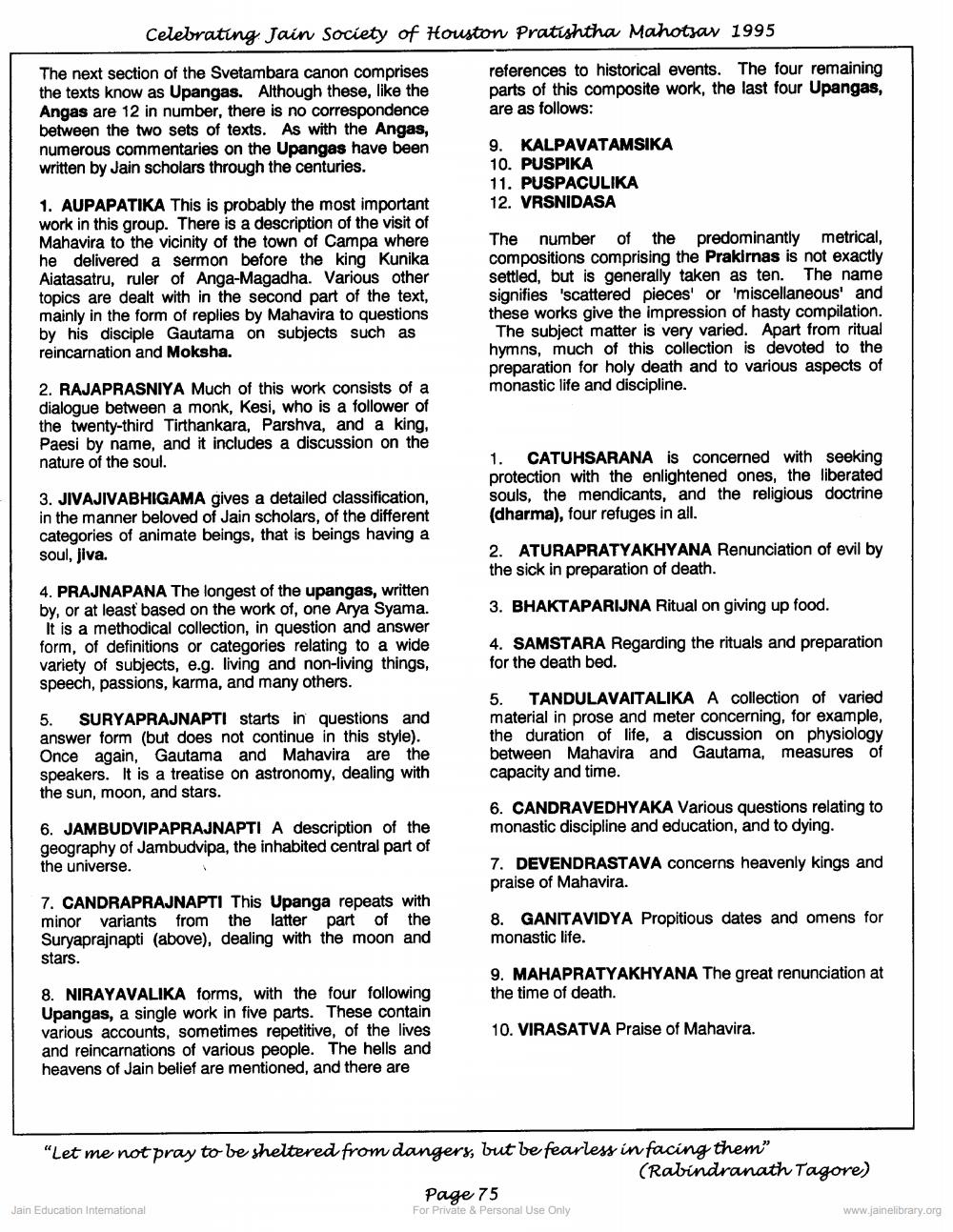________________
Celebrating Jain Society of Houston Pratishtha Mahotsav 1995
references to historical events. The four remaining parts of this composite work, the last four Upangas, are as follows:
The next section of the Svetambara canon comprises the texts know as Upangas. Although these, like the Angas are 12 in number, there is no correspondence between the two sets of texts. As with the Angas, numerous commentaries on the Upangas have been written by Jain scholars through the centuries.
9. KALPAVATAMSIKA 10. PUSPIKA 11. PUSPACULIKA 12. VRSNIDASA
1. AUPAPATIKA This is probably the most important work in this group. There is a description of the visit of Mahavira to the vicinity of the town of Campa where he delivered a sermon before the king Kunika Aiatasatru, ruler of Anga-Magadha. Various other topics are dealt with in the second part of the text, mainly in the form of replies by Mahavira to questions by his disciple Gautama on subjects such as reincarnation and Moksha.
The number of the predominantly metrical, compositions comprising the Prakirnas is not exactly settled, but is generally taken as ten. The name signifies 'scattered pieces' or 'miscellaneous' and these works give the impression of hasty compilation.
The subject matter is very varied. Apart from ritual hymns, much of this collection is devoted to the preparation for holy death and to various aspects of monastic life and discipline.
2. RAJAPRASNIYA Much of this work consists of a dialogue between a monk, Kesi, who is a follower of the twenty-third Tirthankara, Parshva, and a king, Paesi by name, and it includes a discussion on the nature of the soul.
3. JIVAJIVABHIGAMA gives a detailed classification, in the manner beloved of Jain scholars, of the different categories of animate beings, that is beings having a soul, jiva.
1. CATUHSARANA is concerned with seeking protection with the enlightened ones, the liberated souls, the mendicants, and the religious doctrine (dharma), four refuges in all.
2. ATURAPRATYAKHYANA Renunciation of evil by the sick in preparation of death.
3. BHAKTAPARIJNA Ritual on giving up food.
4. PRAJNAPANA The longest of the upangas, written by, or at least based on the work of, one Arya Syama.
It is a methodical collection, in question and answer form, of definitions or categories relating to a wide variety of subjects, e.g. living and non-living things, speech, passions, karma, and many others.
4. SAMSTARA Regarding the rituals and preparation for the death bed.
5. SURYAPRAJNAPTI starts in questions and answer form (but does not continue in this style). Once again, Gautama and Mahavira are the speakers. It is a treatise on astronomy, dealing with the sun, moon, and stars.
5. TANDULAVAITALIKA A collection of varied material in prose and meter concerning, for example, the duration of life, a discussion on physiology between Mahavira and Gautama, measures of capacity and time.
6. CANDRAVEDHYAKA Various questions relating to monastic discipline and education, and to dying.
6. JAMBUDVIPAPRAJNAPTI A description of the geography of Jambudvipa, the inhabited central part of the universe.
7. DEVENDRASTAVA concerns heavenly kings and praise of Mahavira.
7. CANDRAPRAJNAPTI This Upanga repeats with minor variants from the latter part of the Suryaprajnapti (above), dealing with the moon and stars.
8. GANITAVIDYA Propitious dates and omens for monastic life.
9. MAHAPRATYAKHYANA The great renunciation at the time of death.
8. NIRAYAVALIKA forms, with the four following Upangas, a single work in five parts. These contain various accounts, sometimes repetitive, of the lives and reincarnations of various people. The hells and heavens of Jain belief are mentioned, and there are
10. VIRASATVA Praise of Mahavira.
"Let me not pray to be sheltered from dangers, but be fearless in facing them"
(Rabindranath Tagore) Page 75
Jain Education Intemational
For Private & Personal Use Only
www.jainelibrary.org




